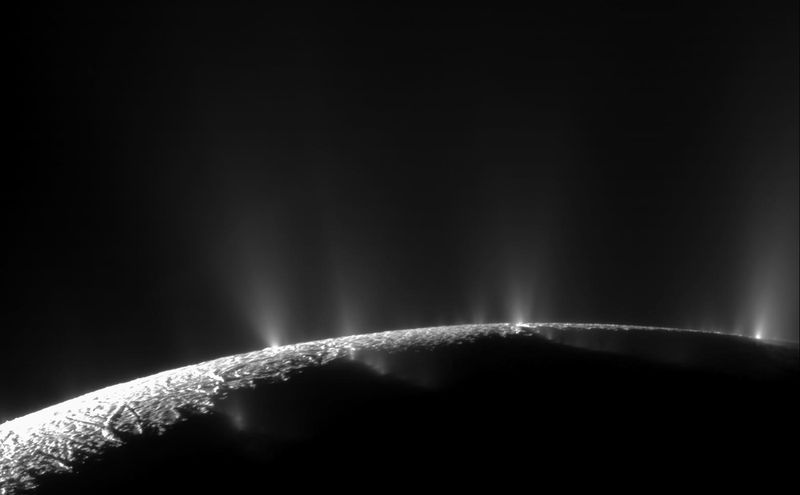Experiments show that these organic molecules can resist radiation just below the ice, allowing future robotic landers to access them without requiring deep drilling.
Examining the potential for life in icy moons
There is evidence of oceans beneath the icy crusts of Jupiter’s moon Europa and Saturn’s moon Enceladus. The NASA experiment suggests that if these oceans support life, signs of life in the form of organic molecules (amino acids, nucleic acids, etc.) could survive just below the ice surface, despite the harsh radiation on these worlds. If robotic landers are sent to these moons to search for signs of life, they won’t have to go very deep to find amino acids that have survived without being altered or destroyed by the radiation.
“Based on our experiments, the ‘safe’ sampling depth for amino acids on Europa is about 8 inches (about 20 centimeters) at high latitudes in the trailing hemisphere (the hemisphere opposite the direction of Europa’s motion around Jupiter). The surface has not been heavily impacted by meteorite impacts, said Oleksandr Pavlov of NASA’s Goddard Space Flight Center in Greenbelt, Maryland, lead author of a paper on the study published July 18 in the journal Nature. Astrobiology.
“Detection of amino acids on Enceladus does not require subsurface sampling; these molecules will survive radiolysis (destruction by radiation) anywhere on the surface of Enceladus that is less than a tenth of an inch (less than a few millimeters) below the surface.”
The frigid surfaces of these nearly airless moons are likely uninhabitable, both because of radiation from high-speed particles captured by the host planet’s magnetic fields and powerful deep-space events such as stellar explosions. But both have oceans beneath their icy surfaces, heated by the gravitational pull of the host planet and nearby moons. If they had other needs, such as energy sources and the elements and compounds used in biological molecules, these subsurface oceans could support life.
Experimental approaches and results
The team used amino acids in radiolysis experiments as possible representatives of biomolecules on icy moons. Amino acids can be created by life or by non-biological chemistry. However, detecting certain types of amino acids on Europa or Enceladus could be a potential sign of life because they are used by life on Earth as components of proteins. Proteins are essential for life because they are used to make enzymes that speed up or regulate chemical reactions and to build structures. Amino acids and other compounds from the subsurface oceans can be brought to the surface by geysers or the slow movement of the ice crust.
To assess the survival of amino acids on these worlds, the team mixed amino acid samples with ice cooled to about minus 321 degrees Fahrenheit (-196 Celsius) in sealed airless bottles and bombarded them with gamma rays, a type of high-energy radiation, in different doses. Because oceans can harbor microscopic life, they also tested the survival of amino acids in dead bacteria in the ice. Finally, they tested amino acid samples in ice mixed with silicate dust to assess the possibility of material from meteorites or the interior mixing with the surface ice.
Implications for future space missions
The experiments provided key data to determine the rate at which amino acids decay, called radiolysis constants. Using this data, the team used the age of the ice surface and the radiation environment on Europa and Enceladus to calculate the depth of drilling and where 10 percent of the amino acids could survive radiolytic decay.
Although experiments have been done before to test the survival of amino acids in ice, this is the first to use lower doses of radiation that do not completely break down the amino acids, but rather break them down so much that it is impossible to tell if they are simply altered and are potential signs of life. It is also the first experiment to use Europa/Enceladus conditions to assess the survival of these compounds in microorganisms, and the first experiment to test the survival of amino acids mixed with dust.
The team found that amino acids decomposed more quickly when mixed with dust, but more slowly when they came from microorganisms.
“The slow rates of amino acid degradation in biological samples under conditions similar to the surface of Europa and Enceladus strengthen the case for future life-detection measurements by Europa and Enceladus lander missions,” said Pavlov. “Our results suggest that the degradation rates of potential organic biomolecules in silica-rich regions on both Europa and Enceladus are higher than in pure ice, and therefore potential future missions to Europa and Enceladus should be careful when sampling silica-rich regions, as both are icy moons.”
One potential explanation for why amino acids survive longer in bacteria is how ionizing radiation alters molecules—either directly by breaking their chemical bonds or indirectly by forming reactive compounds nearby, which then alter or destroy the molecule in question. It is possible that the bacterial cell material protects the amino acids from the reactive compounds produced by the radiation.













